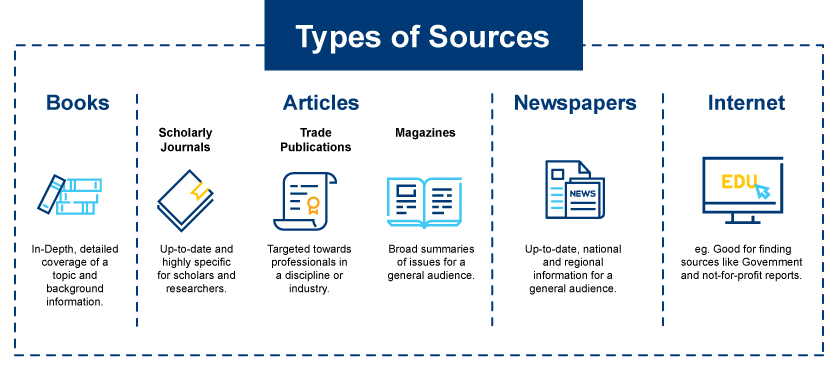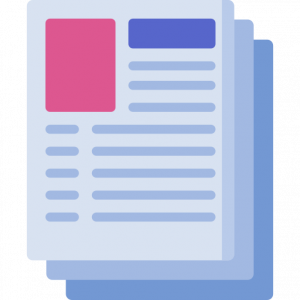Chapter 6: Finding Credible Sources
Characteristics of Popular and Scholarly Writing
These are common types of sources you are likely to come across during your information searches:
In the sea of information we want to choose information that is reliable and credible. That means, information published by well known sources accepted by the scholarly community written by knowledgeable authors. Here are some examples of popular and scholarly writing sources you may come across during your information searches. Understanding and identifying popular writing helps you evaluate sources to determine if they’re appropriate to include in your paper or project.
Popular
Scientific discoveries are reported to people through both popular and scholarly writing. Popular publications (also called consumer publications) aim to inform readers about issues of common interest to the general public. Examples of popular writing which many of you are familiar with include publications such as the Vancouver Sun and Maclean’s.
Characteristics of Popular Writing
Purpose: Inform, entertain, sell products, or promote a viewpoint
Audience: General public
Author: Journalists who may or may not have subject expertise
Content: Simple and non-technical language; many graphics, photographs, and illustrations; rarely cites other sources; submitted articles are only reviewed by the editor of the publication
Popular Science
Popular science magazines are simply popular publications targeted at readers who are interested in science.
Characteristics of Popular Science Writing
Popular science magazines and articles share the same characteristics as general magazines except for these differences:
- The audience is the general public interested in scientific stories.
- They’re written by journalists who often have subject expertise.
- The language may be more technical than that used in newspapers and other popular magazines.
Examples
Scholarly Writing
You will be expected to include scholarly sources in your writing for this course and others in your program. A scholarly publication contains articles written by experts in a particular field of study. The principal readers of these articles are other experts and students. As a result, the articles are typically more advanced than ones found in popular magazines. Rather than calling this kind of publication a magazine, we commonly use the term journal. Journals are a very important part of the process by which scholars communicate. Scientists rely on journals to disseminate the results of their experiments and to find out about other research in their field of study.
Exercise
Activity: Explore one of the following websites. Look at the Table of Contents of an issue to see how the articles differ from popular writing. Can you get to the full text of an actual article?
Characteristics of Popular Scholarly Writing
- The main purpose is to report on original research, experimentation, methodology, and theory.
- Audience includes professors, researchers, college and university students.
- Assume readers have an understanding of the topic (either basic or advanced, depending on the level of the journal).
- Often contains charts, graphs and tables.
- Always cites sources in bibliographies or footnotes.
- Written by scholars or researchers in the field.
- Uses the specialized language of the discipline.
- Articles submitted for publication are reviewed by other experts in the field (known as PEER REVIEWED or REFEREED publications).
Adaptations
Material in this section has been adapted from from Library Research Skills for Land and Food Systems by Katherine Miller, Sally Taylor, Katherine Kalsbeek, Suzan Zagar, Megan Brown, Maggie Fabber, licensed under a Creative Commons Attribution-ShareAlike 4.0 International License.
Media Attributions
- Types of Sources © Toronto Metropolitan University is licensed under a CC BY (Attribution) license
- application © Freepik is licensed under a CC BY (Attribution) license
Something that is trustworthy and reliable.
To spread, share, or disperse information.
When you’re writing, it’s easy to forget that you are actually writing to someone. Whether you’ve thought about it consciously or not, you always write to an audience: sometimes your audience is a very generalized group of readers, sometimes you know the individuals who compose the audience, and sometimes you write for yourself. Keeping your audience in mind while you write can help you make good decisions about what material to include, how to organize your ideas, and how best to support your argument. (from The Writing Center, University of North Carolina at Chapel Hill)



